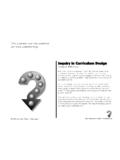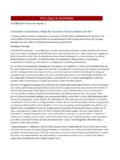Transcription of Topic 2: What is human factors and why is it important to ...
1 100 Topic 2: What is human factors and why is it important topatient safety?Why human factors is important human factors examines the relationshipbetween human beings and the systems withwhich they interact [1] by focusing on improvingefficiency, creativity, productivity and jobsatisfaction, with the goal of minimizing errors. Afailure to apply human factors principles is a keyaspect of most adverse events in health , all health-care workers need to have abasic understanding of human factors workers who do not understand thebasics of human factors are like infection controlprofessionals not knowing about factors , ergonomics, systems, objectiveUnderstand human factors and its relationship topatient outcomes: knowledgeand performanceWhat a student needs to know (knowledge requirements): explain the meaning of the term human factors ; explain the relationship between humanfactors and patient a student needs to do (performancerequirement): apply human factors thinking to yourwork STUDENTS NEED TO KNOW(KNOWLEDGE REQUIREMENTS)The meaning of the terms humanfactors and ergonomics The terms human factors and ergonomics(as it is sometimes called) are used to describeinteractions between three interrelated aspects:individuals at work, the task at hand and theworkplace itself.
2 human factors is an established science that usesmany disciplines (such as anatomy, physiology,physics and biomechanics) to understand howpeople perform under different circumstances. We define human factors as: the study of all thefactors that make it easier to do the work in theright definition of human factors is the study ofthe interrelationship between humans, the toolsand equipment they use in the workplace, and theenvironment in which they work [1]. One can apply human factors knowledge towherever humans work. In health care, humanfactors knowledge can help design processes thatmake it easier for doctors and nurses to do thejob right. human factors applications are highlyrelevant to patient safety because embedded inthe discipline of human factors engineering are thebasic sciences of safety. human factors can showus how to make sure we use safe prescribingpractices, communicate well in teams and handover information to other health-careprofessionals.
3 These tasks, once thought to bebasic, have become quite complicated as a resultof the increasing complexity of health-careservices and systems. Much of health care isdependent on the humans the doctors andnurses providing the care. human factorsexperts believe that mistakes can be reduced byfocusing on the health-care providers andstudying how they interact with and are part of theenvironment. human factors can make it easierfor health-care providers to care for factors principles can be adapted to anyenvironment, and industries such as aviation,54321101manufacturing and the military have appliedknowledge of human factors to improve systemsand services for many years now [2].The lessons and examples from other industriesshow that by using human factors principles wecan also improve work processes in health example, the underlying causes of manyadverse events relate to the miscommunicationsand actions of the people in the system.
4 Manypeople think that communication difficulties amongthe health-care team relate to the fact that eachperson has a number of tasks that have to beperformed at one time. human factors engineeringresearch shows that what is important is not thenumber of tasks but the nature of the tasks beingattempted. A doctor may be able to tell a studentthe steps in a simple operation while he is doingone but if it was a complicated case he may not beable to do that because he has to concentrate. Anunderstanding of human factors and adherence tohuman factors principles is now fundamental to thediscipline of patient safety [3]. human factors experts help make it easier for thewidest range of health-care providers to performat their best while caring for patients. This isimportant because the goal of good humanfactors design is to accommodate all the users inthe system. This means not just thinking aboutdesign issues as though the task was to beaccomplished not only by a calm, restedexperienced clinician, but also for aninexperienced health-care worker who might bestressed, fatigued and rushing.
5 human factors experts use evidence-basedguidelines and principles to design ways to makeit easier to safely and efficiently do things such as:(i) order medications; (ii) hand off (hand over)information; (iii) move patients; and (iv) chartmedications and other orders electronically. Ifthese tasks were made easier for the health-carepractitioner, then they would be able to providesafer health care. These tasks require designsolutions that include software (computer orderentry systems), hardware (IV pumps), tools(scalpels, syringes, patient beds) and the physical layout, including lighting of work environments. The technological revolution in health care hasincreased the relevance of human factors in errorsbecause the potential for harm is great whentechnology is mishandled [3].In its broadest sense human factors incorporatesthe human machine interactions (includingequipment design) and human huzmaninteractions such as communication, teamworkand organizational culture.
6 human factorsengineering seeks to identify and promote thebest fit between people and the world withinwhich they live and work, especially in relation tothe technology and physical design features intheir work environment. human factors recognize that the workplaceneeds to be designed and organized to minimizethe likelihood of errors occurring and the impact oferrors when they do occur. While we cannoteliminate human fallibility, we can act to moderateand limit the risks. Note that human factors is not as directlyabout humans as the name might suggest. But it isabout understanding human limitations anddesigning the workplace and the equipment weuse to allow for variability in humans and humanperformance. Knowing how fatigue, stress, poor communicationand inadequate knowledge and skill affect healthprofessionals is important because it helps usunderstand predisposing characteristics that maybe associated with adverse events and 2: What is human factors and why is it important to patient safety?
7 102 Topic 2: What is human factors and why is it important to patient safety?The fundamental basis of human factors relates tothe issue of how human beings processinformation. We acquire information from theworld around us, interpret and make sense of itand then respond to it. Errors can occur at eachstep in this process (see Topic 5 on understandingand learning from errors). human beings are not machines; machines, whenmaintained, are on the whole very predictable andreliable. In fact, compared to machines, humansare unpredictable and unreliable, and our ability toprocess information is limited due to the capacityof our (working) memory. However, human beingsare very creative, self-aware, imaginative andflexible in their thinking [4]. human beings are also distractible, which is both astrength and a weakness. Distractibility helps usnotice when something unusual is happening. Weare very good at recognizing and responding tosituations rapidly and adapting to new situations andnew information.
8 However, our ability to bedistracted also predisposes us to error, because bybeing distracted we may not pay attention to themost important aspects of a task or a medical student taking blood from apatient. As the student is in the process of cleaningup after taking the blood, a patient in a neighbouringbed calls out for assistance. The student stops whatshe is doing and goes to help and forgets that theblood tubes are not labelled, which the studentforgets when she returns to collect the tubes. Orconsider a nurse who is taking a medication orderover the telephone and is interrupted by a colleagueasking a question; the nurse may mishear or fail tocheck the medication or dosage as a result of brain can also play tricks on us bymisperceiving the situation and thereby contributeto errors fact that we can misperceive situationsdespite the best of intentions is one of the mainreasons that our decisions and actions can beflawed, resulting in making silly mistakes regardless of experience level, intelligence,motivation or vigilance.
9 In the health-care setting,we describe these situations as errors, which mayhave consequences for patients. These are important considerations to recognizebecause they are reminders that making errors isnot so much bad as inevitable. In simple terms,error is the downside of having a brain. Reason [4]described error as the failure of a planned actionto achieve its intended outcome or a deviationbetween what was actually done and what shouldhave been done. The relationship between humanfactors and patient safetyIt is important for all health-care workers to bemindful of situations that increase the likelihood of error for human beings in any situation [5]. This is especially important for medical students and other inexperienced junior staff to be aware number of individual factors impact on humanperformance thereby predisposing a person toerror. Two factors with the most impact are fatigue andstress. There is strong scientific evidence linkingfatigue and performance decrement making it aknown risk factor in patient safety [6].
10 Prolongedwork has been shown to produce the samedeterioration in performance as a person with a blood alcohol level of mmol/l, which would make it illegal to drive a car in many countries [7]. The relationship between stress levels andperformance has also been confirmed through28272624252122231819201617103 Topic 2: What is human factors and why is it important to patient safety?research. While high stress is something thateveryone can relate to, it is important to recognizethat low levels of stress are alsocounterproductive, as this can lead to boredomand failure to attend to a task with appropriatevigilance. The aviation industry requires individual pilots touse a number of personal checklists to monitortheir performance an approach that health-careworkers could easily emulate. All health-careworkers should consider using a series ofpersonal error reduction strategies to ensure thatthey perform optimally at work. The acronym IM SAFE (illness, medication, stress,alcohol, fatigue, emotion) that was developed inthe aviation industry is useful as a self-assessmenttechnique to determine when entering theworkplace each day whether a person is safe for STUDENTS NEED TO DO(PERFORMANCE REQUIREMENTS)Apply human factors thinking to yourwork environment [8] Medical students are able to apply human factorsthinking as soon as they enter a hospital or clinicenvironment.














![The Ontario Curriculum, Grades 1-8, Language [revised] 2006](/cache/preview/d/5/3/5/d/c/7/4/thumb-d535dc7439a04910d8a17bf7f1d6b83f.jpg)


